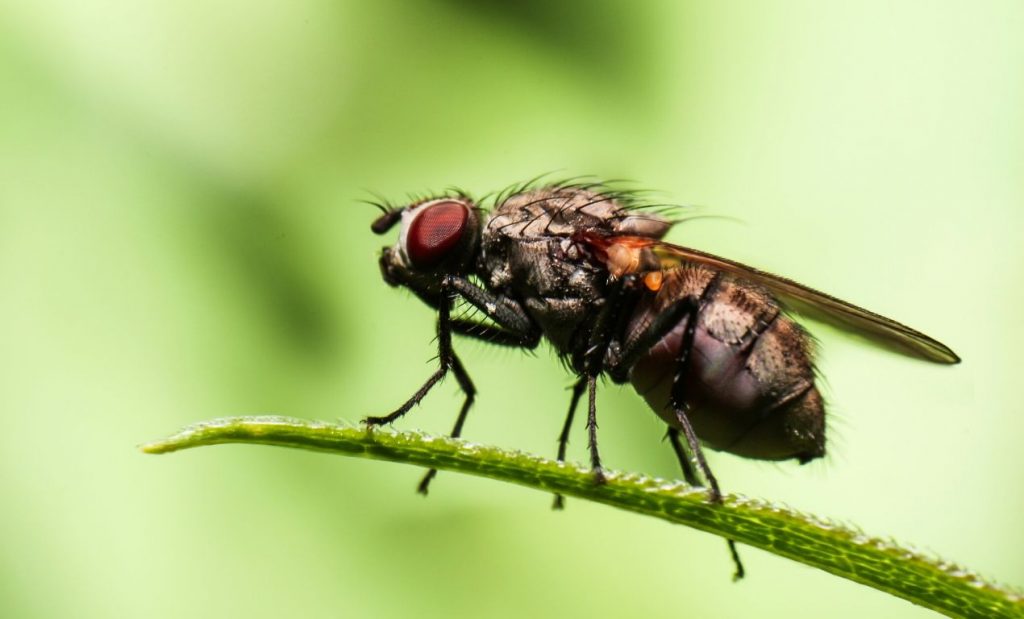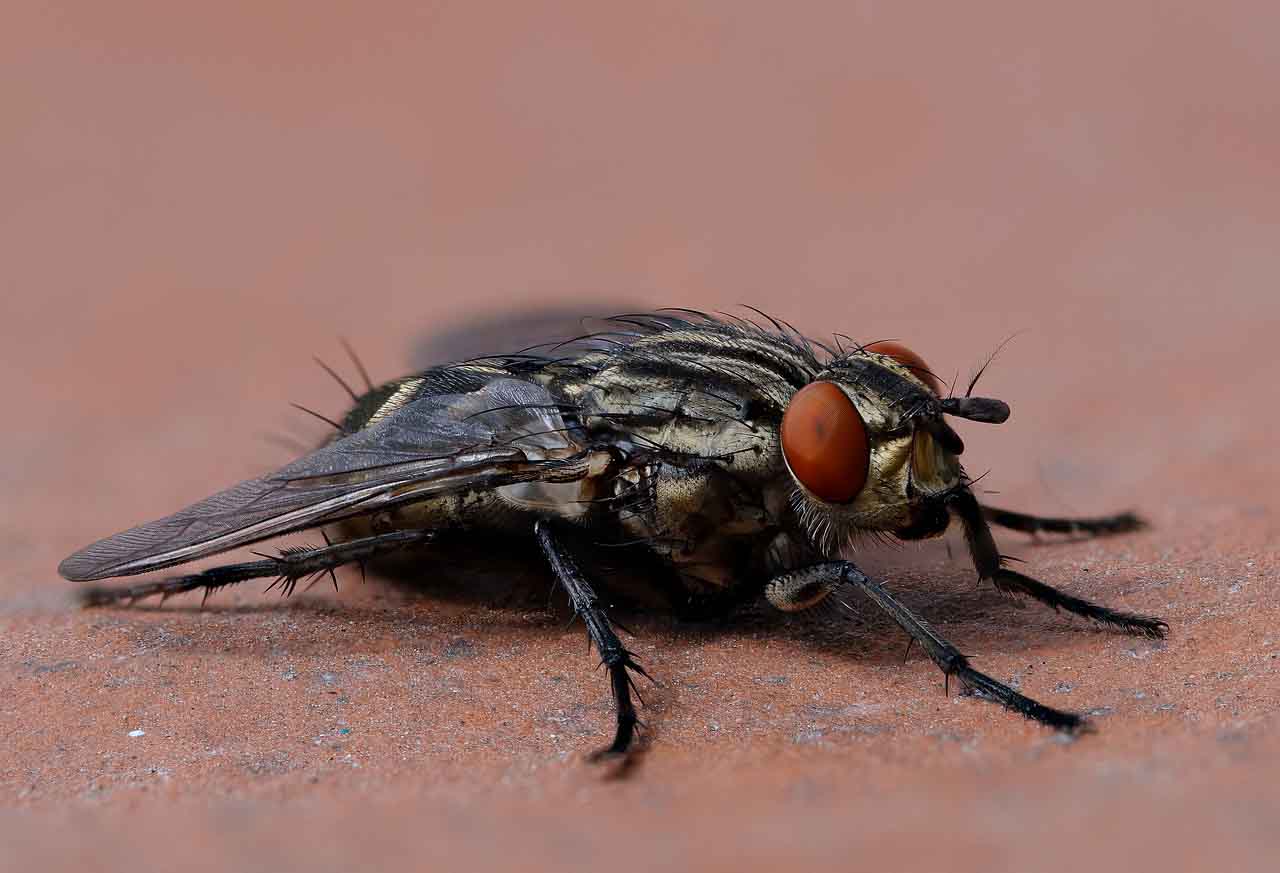
 There are more than three lakh species of flies. House flies are the most famous and get found near the human habitat. They get seen all over the world, including Antarctica. They can look around them i.e. they have 360 degree vision and they have that they need to have many lenses.
There are more than three lakh species of flies. House flies are the most famous and get found near the human habitat. They get seen all over the world, including Antarctica. They can look around them i.e. they have 360 degree vision and they have that they need to have many lenses.
So, how many lenses does a fly have? Male fly have around 4,500 lenses, and the female fly have around 4,000 lenses. That’s a lot. These lenses gives them 360 degree vision and the moment they see any big object coming near them they immediately react and flies away to protect their life.
Compound Eyes
A series of eyes bound or compounded together is known as compound eyes. This eye gets made of multiple ‘eyes’ or prismatic units, known as ommatidia. Each ommatidium appears on the surface of the compound eyes as a dome, called the facet. Each facet can either be hexagonal, squarish, hemispherical, or roundish. Hence a compound eye gets made of all types of facets without leaving any gaps in between.
The more facets that get compounded in an area, the more the light passes through it to the brain. Each of these light points or pixels would provide a better final image to the insect. In humans, there is one corneal lens, which focuses the light on the retina. This retina has optic nerves or sensory cells, which transmits to the brain the final image the eyes see.
There is an innumerable number of sensory cells in the human retina. In the most sensitive part, there are more than 175,000 cells per square millimeter, compared to around 7 to 11 in each ommatidium. House flies have about 4,000 such eyes and an equivalent number of sensory cells. Males have a more significant amount of ommatidia compared to females. Depending upon the packing of the facets, those parts of the eyes have better visibility due to the presence of more sensory cells.
Structure Of An Ommatidia
Each ommatidium consists of cornea or facet. The next part is the crystalline cone, enclosed by upper iris and matrix cells. The cone ends at the rhabdom, encircled by the lower iris and sensory cells. Each of these ommatidia gets connected to the brain with axons or optic nerves.
The light entering from the facet gets focused by the crystalline cone to the rhabdom. This optic rod or rhabdom gets made of light-sensitive pigments known as rhodopsins. The ommatidium is an energy transducer, i.e., the light stimulus absorbed by the rhabdom gets converted into electrical energy, which gets carried to the optic lobes of the brain by the optic nerves.
Lenses
 The ommatidia of flies have photo-pigment bearing membranes as rodlets, comprising of the rhabdom. Each of these rhabdomeres gets connected to its axon. There are seven such rodlets in each ommatidium in flies. Flies generally have between 4,000 to 4,500 ommatidia, which implies thousands of axons carry light and images at various angles to the brain.
The ommatidia of flies have photo-pigment bearing membranes as rodlets, comprising of the rhabdom. Each of these rhabdomeres gets connected to its axon. There are seven such rodlets in each ommatidium in flies. Flies generally have between 4,000 to 4,500 ommatidia, which implies thousands of axons carry light and images at various angles to the brain.
Since this transfer occurs electrically, the turnaround time is quicker for the brain to decipher the image, shades of lights, and motion. Since each ommatidium has a facet, male flies have around 4,500 lenses, while the female around 4,000.
Photoreceptors
Photoreceptors are cells in the retina or rhabdom, which responds to light. In flies, these projections are fingerlike structures known as microvilli. Each of these microvilli can identify different wavelengths of light. The dark granules found in these receptors, move forward to protect the rhabdomeres from harsh light.
Acuity
The visual acuity is the quality of vision obtained from an optical instrument. Even though there are many eyes in a compound eye, the human eye has a hundred times more visual acuity compared to the best compound eye of the dragonfly, which has around 30,000 ommatidia. This quality depends upon the density of light-sensitive cells, present on the retina.
Color
The compound eyes of flies do not see too many colors. They see the light and shade and some colors in the higher wavelength of the spectrum. They are also able to see the polarized and ultra-violet rays. Their eyes cannot discern shading, vividness, and sharpness of color in the light.
Function
The function of compound eyes in an insect is to prey and escape from predators. To prey, flies use their antenna along with their compound eyes. Since they mostly feed on dead and decaying matter, they don’t require to focus much to feed. However, with their 360-degree vision, they can see large forms and the speed at which it is approaching. This is good enough for the flies to take evasive action and save themselves. Hence it is difficult to swat a fly with a newspaper.
How Do Flies Dodge Human Swats?
The compound eyes of flies work on the principle of mechanical force converted to an electrical impulse, compared to chemical reactions in humans. Hence, flies see things seven times faster than us. When we use a newspaper to strike a sitting fly, he can see this movement in slow motion and has enough time to get out of the way. The ray of light entering the facet and striking the rhabdomere, which immediately informs the brain thro’ it’s individual optic nerves.
The Difference Between Human And Eyes Of Flies
Human eye:When we see an object, this ‘seeing’ is a very complicated process, thro’ which we can see something instantly. When light source enter thro’ our eyes, the corneal lens, projects the image onto our screen or retina. The light patterns get analyzed by the optical nerves; the occipital lobe translates these forms into images, which our mind can decipher. Our forward-looking eyes can identify depth and perspective but are limited to a specific range of wavelengths. We cannot see much in low light, in the darkness, or behind our heads.
Eyes of flies:The compound eyes of the flies, project outward, on top of the head. They can see all around them. Their eyes have thousands of optical units, known as ommatidia. These large numbers of lens-like structures improve the resolution of the images they see. They see many forms and shades, but their images are not sharp and crisp, like the way a human sees. Flies can see many designs and shades of ultra-violet (UV) wavelengths, which humans cannot.
Vision Of Flies
 The perfect human vision is 20/20, while a housefly has a vision of 20/1200. Though they can see lots of light, shade, and motion, their compound eyes cannot focus on objects or see any color and their shades vividly. Flies cannot see the red color, which gets found on the lower wavelength of the spectrum. They can discern lights traveling on a horizontal plane, also known as polarized lights.
The perfect human vision is 20/20, while a housefly has a vision of 20/1200. Though they can see lots of light, shade, and motion, their compound eyes cannot focus on objects or see any color and their shades vividly. Flies cannot see the red color, which gets found on the lower wavelength of the spectrum. They can discern lights traveling on a horizontal plane, also known as polarized lights.
Polarised Light
When light travels in one direction or plane, they are known as polarized light. These get perceived by humans but not get seen. Compound eyes of flies can see this polarized light, especially those traveling horizontally. When sunlight reflects directly into your eyes from a shining surface is the polarized light, which flies can see very well.
Ocelli
Flies don’t see as humans. With their compound eyes, they see various lights, shades, and motion. They join them together to get a lovely mosaic view, which is hazy and not crisp, vivid, or focussed. Flies have three simple eyes or the ocelli, between the two large compound eyes. These ocelli help the flies with the direction and balance and not with the actual sight. They keep track of sunlight and guides the fly towards it.
Flies At Night
They require polarized light to get guided at night. Hence they prefer to rest after a hard day’s labor. They usually rest under leaves, on branches, along the trunk. Any shady, cool place is suitable for them to rest. Like humans, they also sleep light and heavy. Flies don’t nests and colonies. They sleep anywhere.
Some Interesting Facts About Flies
- Houseflies reach up to one-fourth inch in length.
- They are generally grey, with four black stripes at the back.
- They have one pair of the membraneous wing to fly. The second short wing, known as halters, gets used in balancing during flying.
- Flies move their wings two hundred times per second.
- Their legs have small pads with a hairy surface. These legs secrete a sticky substance on which they sit so that they do not topple over, even with a stiff breeze.
- Their compound eyes look red. Though they have over 4000 eyes or ommatidia, they are unable to focus on objects.
- They secrete a digestive juice on their food, liquefies the same, and then ingests it.
- They are carriers of a large number of pathogen-related diseases.
- They secrete waste quite regularly, leading to ingestion of this thro’ food by humans.
- Females lay about 2,000 eggs in a batch of 50-75 eggs at a time, and the complete developmental cycle takes around ten days.
- Adult flies live between thirty to sixty days.
- The taste receptors of flies get located on the underside of the legs.
- Male flies are always looking for their female partners.
- With their compound eyes, they can see all around them.
Conclusion
Flies have compound eyes, which has over 4,000 simple eyes or ommatidia. Though they have a similar number of lenses, they can see only light, shadow, and movement. Since the transmission of light to rhabdom and this information getting conveyed to its brain is so quick, they can see four to five times faster than humans.
Which means that they perceive any movement quicker than us. The only area of concern with their compound eye is that it cannot focus and see a sharp image or a vivid color. There’s lots of light, including UV and polarised, but everything is hazy!
Welcome to my blog. I have been doing pest control for years since my house, garden and pets were always attacked by various kinds of pests and as a result I had to know proper pest control techniques that works. In this blog I share all the tips and tricks that I know and I hope you’ll find it helpful.
